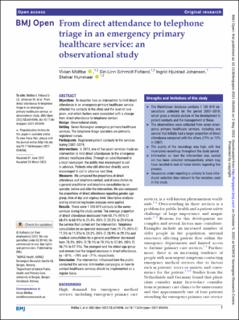| dc.contributor.author | Midtbø, Vivian | |
| dc.contributor.author | Fotland, Siri-Linn Schmidt | |
| dc.contributor.author | Johansen, Ingrid Hjulstad | |
| dc.contributor.author | Hunskår, Steinar | |
| dc.date.accessioned | 2022-10-06T06:43:38Z | |
| dc.date.available | 2022-10-06T06:43:38Z | |
| dc.date.created | 2022-06-03T08:19:00Z | |
| dc.date.issued | 2022 | |
| dc.identifier.issn | 2044-6055 | |
| dc.identifier.uri | https://hdl.handle.net/11250/3024167 | |
| dc.description.abstract | Objectives To describe how an intervention to limit direct attendance in an emergency primary healthcare service affected the contacts to the clinic and the level of care given, and which factors were associated with a change from direct attendance to telephone contact. Design Observational study. Setting Seven Norwegian emergency primary healthcare services. The telephone triage operators are primarily registered nurses. Participants Registered patient contacts to the services during 2007–2019. Interventions In 2013, one of the seven services made an intervention to limit direct attendances to the emergency primary healthcare clinic. Through an advertisement in a local newspaper, the public was encouraged to call in advance. Patients who still attended directly, were encouraged to call in advance next time. Measures We compared the proportions of direct attendance and telephone contact, and of consultation by a general practitioner and telephone consultation by an operator, before and after the intervention. We also compared the proportions of direct attendance regarding gender, age group, time of day and urgency level. Descriptive analyses and log binomial regression analyses were applied. Results There were 1 105 019 contacts to the seven services during the study period. The average proportion of direct attendance decreased from 68.7% (95% CI 68.4% to 68.9%) to 23.4% (95% CI 23.2% to 23.6%) in the service that carried out the intervention. Telephone consultation by an operator increased from 11.7% (95% CI 11.5% to 11.8%) to 29.2% (95% CI 28.9% to 29.5%) and medical consultation by a general practitioner decreased from 78.3% (95% CI 78.1% to 78.5%) to 57.0% (95% CI 56.7% to 57.3%). The youngest and the oldest age group and women had the largest decrease in direct attendance, by −81%, −74% and −71%, respectively. Conclusion The intervention influenced how the public contacted the service. Information campaigns on how to contact healthcare services should be implemented on a regular basis. | en_US |
| dc.language.iso | eng | en_US |
| dc.rights | Navngivelse-Ikkekommersiell 4.0 Internasjonal | * |
| dc.rights.uri | http://creativecommons.org/licenses/by-nc/4.0/deed.no | * |
| dc.title | From direct attendance to telephone triage in an emergency primary healthcare service: An observational study | en_US |
| dc.title.alternative | From direct attendance to telephone triage in an emergency primary healthcare service: An observational study | en_US |
| dc.type | Peer reviewed | en_US |
| dc.type | Journal article | en_US |
| dc.rights.holder | © Author(s) (or their employer(s)) 2022 | en_US |
| dc.description.version | publishedVersion | en_US |
| cristin.ispublished | true | |
| cristin.fulltext | original | |
| cristin.qualitycode | 1 | |
| dc.identifier.doi | 10.1136/bmjopen-2021-054046 | |
| dc.identifier.cristin | 2029272 | |
| dc.source.journal | BMJ Open | en_US |
| dc.source.volume | 12 | en_US |
| dc.source.issue | 5 | en_US |

